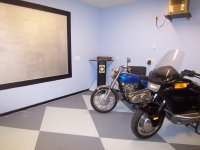I have posted a few pictures of my Dec Ware Corner Horns in the Photo Gallery. Since these speakers are lacking reviews and comments on the Internet, I thought that should post a few.
I built these speakers from Steve's template. They are using Fostex FE166En full range drivers.
The cabinets took about two weeks of part time work to complete. There is a number of steep compound angles to cut and everything needs to be fairly accurate to fit correctly. They were not hard to built, but they were very time consuming. About one half of the construction time was waiting of glue and paint to cure on internal parts.
View attachment 178682
My first thought on initial power-up was, "My, there certainly is a lot of music coming out of these little 6 inch speakers."
Many years ago, I had a cottage loud speaker company and still have all the old test gear, so I hooked up the frequency generator and analyzer and sound meters and gave them a sweep.
The good news is that I can still hear 15,000 Hz.
As expected, the Dec Horns pretty much follow the Fostex curve down to 150 Hz. then the horn portion kicks in a provides full deep bass down to 43 Hz. Below that, the speaker is still moving energetically, but not much usable sound is being generated. Must be why they call it the cutoff frequency.
The high end is exceptionally clear, my instruments show high frequencies extending out to 20k. About the only criticism would be that a few female voices and some higher pitched horns are a bit strident. This may just be the recording since other voices and horns come through wonderfully.
Also, these speakers are in my 500 sq. ft. motorcycle garage and the only acoustic treatment is moving the Norton a few feet one way or the other.
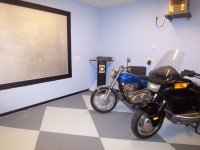
My audioholic friends, both young an old, are amazed with the bass that is coming out of a 6 inch speaker. It is more than the equal of the ported 15 inch and sealed 12 inch woofers that we ABC test compared. The bass is of the hi-fidelity type and not the booming sub-woofer type. If you need earthquakes and explosions for your home theater, you will still need subs.
Low frequency instruments such as bass fiddles, bass guitars, kettle drums and horns sound very acoustical and have a resonance that is incredibly realistic.
These speakers are very accurate and very efficient.
One watt is nightclub loud and 10 watts is rock concert pounding loud.
A drawback, perhaps, is that the corner locations combined with the deep base produces some very noticeable standing waves. With the tone generator set at 85hz, there is a 12 db difference between peak and void as the sound meter is moved around the room. The couch is now sitting in a peak, the bass is ever so good.
With 20 feet between speakers, the sound stage is enormous...
if you are sitting in a sweet spot. 10 feet back and centered is a great spot. 10 more feet back is even better. Move five feet in any direction and you will be in a bass free zone and all the singing will be coming from one speaker. Good seating location is critical.
Plan on rearranging the furniture.
Other than the large investment in time, these speakers are quite inexpensive to built. $50 for the plans, $120 for the MDF, paint and glue, and $150 for the Fostex FE166Ens.
If you have the corners, and if you have the room, these speakers are well worth the time and effort that it takes to build them.
Dennis
I built these speakers from Steve's template. They are using Fostex FE166En full range drivers.
The cabinets took about two weeks of part time work to complete. There is a number of steep compound angles to cut and everything needs to be fairly accurate to fit correctly. They were not hard to built, but they were very time consuming. About one half of the construction time was waiting of glue and paint to cure on internal parts.
View attachment 178682
My first thought on initial power-up was, "My, there certainly is a lot of music coming out of these little 6 inch speakers."
Many years ago, I had a cottage loud speaker company and still have all the old test gear, so I hooked up the frequency generator and analyzer and sound meters and gave them a sweep.
The good news is that I can still hear 15,000 Hz.
As expected, the Dec Horns pretty much follow the Fostex curve down to 150 Hz. then the horn portion kicks in a provides full deep bass down to 43 Hz. Below that, the speaker is still moving energetically, but not much usable sound is being generated. Must be why they call it the cutoff frequency.
The high end is exceptionally clear, my instruments show high frequencies extending out to 20k. About the only criticism would be that a few female voices and some higher pitched horns are a bit strident. This may just be the recording since other voices and horns come through wonderfully.
Also, these speakers are in my 500 sq. ft. motorcycle garage and the only acoustic treatment is moving the Norton a few feet one way or the other.

My audioholic friends, both young an old, are amazed with the bass that is coming out of a 6 inch speaker. It is more than the equal of the ported 15 inch and sealed 12 inch woofers that we ABC test compared. The bass is of the hi-fidelity type and not the booming sub-woofer type. If you need earthquakes and explosions for your home theater, you will still need subs.
Low frequency instruments such as bass fiddles, bass guitars, kettle drums and horns sound very acoustical and have a resonance that is incredibly realistic.
These speakers are very accurate and very efficient.
One watt is nightclub loud and 10 watts is rock concert pounding loud.
A drawback, perhaps, is that the corner locations combined with the deep base produces some very noticeable standing waves. With the tone generator set at 85hz, there is a 12 db difference between peak and void as the sound meter is moved around the room. The couch is now sitting in a peak, the bass is ever so good.
With 20 feet between speakers, the sound stage is enormous...
if you are sitting in a sweet spot. 10 feet back and centered is a great spot. 10 more feet back is even better. Move five feet in any direction and you will be in a bass free zone and all the singing will be coming from one speaker. Good seating location is critical.
Plan on rearranging the furniture.
Other than the large investment in time, these speakers are quite inexpensive to built. $50 for the plans, $120 for the MDF, paint and glue, and $150 for the Fostex FE166Ens.
If you have the corners, and if you have the room, these speakers are well worth the time and effort that it takes to build them.
Dennis
Attachments
Member
Joined 2009
Paid Member
This is the picture that should have been uploaded.
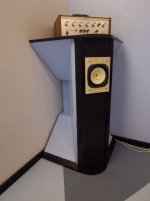
I still need to install the solid oak fronts. The speakers were an experiment.
I could find little info or reviews, so I went into this project with the thought that I might be working on 200 pounds of future kindling. Such it is with things found on the Internet. In this case, I ended up with something extremely satisfying.
These speakers need a bit of Bondo, caulking and paint to finish nicely. It would be really tough to build them out of cabinet grade walnut with a china closet finish. The entire curved front is constructed out of small vertical strips of stock and belt sanded round. A skim coat of Bondo hides the seams.
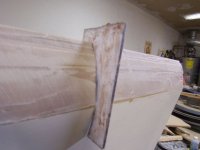
It really helps to make a top and bottom template to hold everything straight and plumb and square. A few degrees of tilt means that every other piece will be a hand fitted trial and error project. And there isn't much room for hands.
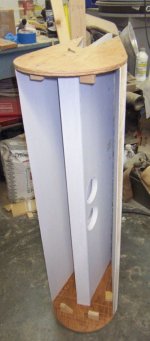
Again, these are not all that hard to make. All the fussy pieces are inside the cabinet and errors can usually be covered with a long handled brush full of caulking. They were much more interesting to build than another rectangular box.
The worst part is that there are a bunch of angled rips in sheets of MDF. Each one produces a quart of fine MDF flour that needs to be corralled.
Dennis

I still need to install the solid oak fronts. The speakers were an experiment.
I could find little info or reviews, so I went into this project with the thought that I might be working on 200 pounds of future kindling. Such it is with things found on the Internet. In this case, I ended up with something extremely satisfying.
These speakers need a bit of Bondo, caulking and paint to finish nicely. It would be really tough to build them out of cabinet grade walnut with a china closet finish. The entire curved front is constructed out of small vertical strips of stock and belt sanded round. A skim coat of Bondo hides the seams.

It really helps to make a top and bottom template to hold everything straight and plumb and square. A few degrees of tilt means that every other piece will be a hand fitted trial and error project. And there isn't much room for hands.

Again, these are not all that hard to make. All the fussy pieces are inside the cabinet and errors can usually be covered with a long handled brush full of caulking. They were much more interesting to build than another rectangular box.
The worst part is that there are a bunch of angled rips in sheets of MDF. Each one produces a quart of fine MDF flour that needs to be corralled.
Dennis
corner horns
Those are beautiful . . . and so are the speakers! The Norton looks near perfectly restored. The exquisite patina on the pipes is proof that it's not some garage queen. The other one's a Honda PCH?
Reading about (and looking at) those speakers has me thinking about taking another shot at building the "Austin" corner horn. It's a 166E design by a talented fullrange driver fan named Ron, who's moniker, at one time, was "Texas Bullfrog". The plan is on the Planet 10 website along with a similar one for the 126E.
It's a simpler build, with no coumpound angles, but I had a hard time trying to make the perfect angle cuts with a circular saw. If I try it again, I'll rout the horn panel layout on one side, kinda like the Madisound BK-16. Then, instead of exact angle cuts, I'd shorten each panel a bit and use 90 degree and 45ish cuts for all. I could glue them into the routed-out slots and fill the resulting narrow spaces with rounds or quarter rounds cut to the same width.
I gather Ron had some health problems, as well as a stressful, free-time forbidding dayjob. I have not seen him post for a long time. I hope he's OK.
Those are beautiful . . . and so are the speakers! The Norton looks near perfectly restored. The exquisite patina on the pipes is proof that it's not some garage queen. The other one's a Honda PCH?
Reading about (and looking at) those speakers has me thinking about taking another shot at building the "Austin" corner horn. It's a 166E design by a talented fullrange driver fan named Ron, who's moniker, at one time, was "Texas Bullfrog". The plan is on the Planet 10 website along with a similar one for the 126E.
It's a simpler build, with no coumpound angles, but I had a hard time trying to make the perfect angle cuts with a circular saw. If I try it again, I'll rout the horn panel layout on one side, kinda like the Madisound BK-16. Then, instead of exact angle cuts, I'd shorten each panel a bit and use 90 degree and 45ish cuts for all. I could glue them into the routed-out slots and fill the resulting narrow spaces with rounds or quarter rounds cut to the same width.
I gather Ron had some health problems, as well as a stressful, free-time forbidding dayjob. I have not seen him post for a long time. I hope he's OK.
The worst part is that there are a bunch of angled rips in sheets of MDF. Each one produces a quart of fine MDF flour that needs to be corralled.
Steve Deckert did recommend against using MDF, preferring plywood instead. Nice looking speakers, though. Next up I guess you're ready to start building a pair of Jubilee?
http://forums.klipsch.com/forums/t/54081.aspx
Nice build 
It looks like the corner horns are not sealed to the wall, and the baseboard also helps extend the gap.. The horns are supposed to be gasket sealed to the wall so there are no leaks as stated in the plans..
Good job taking those on!
From the plans:
STEP 7—INSTALLATION
This cabinet must be installed tight into a corner to work. That is because it uses the
walls to complete the horn flare. You will run into two issues when you go to install the
cabinets into the corners of your room. 1) there will be base boards to deal with and 2)
the corner will not be perfectly square.
BASEBOARDS
For permanent installations you can cut the base board to butt into the cabinet. Another
alternative is to raise the cabinet off the floor to sit just above the baseboards.
And finally, if the baseboards are very thin you may be able to ignore them.
GASKET
Since no corner of any room is perfectly true you will find gaps when you try to butt the
cabinet up against the walls. This is handled by installing a 3/4” wide by 5/8” foam
weather strip (self adhesive type) to all the edges that contact the walls. This ensures
you have an air tight seal against the wall. You must have an air tight seal against the
walls.
It looks like the corner horns are not sealed to the wall, and the baseboard also helps extend the gap.. The horns are supposed to be gasket sealed to the wall so there are no leaks as stated in the plans..
Good job taking those on!
From the plans:
STEP 7—INSTALLATION
This cabinet must be installed tight into a corner to work. That is because it uses the
walls to complete the horn flare. You will run into two issues when you go to install the
cabinets into the corners of your room. 1) there will be base boards to deal with and 2)
the corner will not be perfectly square.
BASEBOARDS
For permanent installations you can cut the base board to butt into the cabinet. Another
alternative is to raise the cabinet off the floor to sit just above the baseboards.
And finally, if the baseboards are very thin you may be able to ignore them.
GASKET
Since no corner of any room is perfectly true you will find gaps when you try to butt the
cabinet up against the walls. This is handled by installing a 3/4” wide by 5/8” foam
weather strip (self adhesive type) to all the edges that contact the walls. This ensures
you have an air tight seal against the wall. You must have an air tight seal against the
walls.
Last edited:
Those are beautiful . . . and so are the speakers! The Norton looks near perfectly restored. The exquisite patina on the pipes is proof that it's not some garage queen. The other one's a Honda PCH?
Reading about (and looking at) those speakers has me thinking about taking another shot at building the "Austin" corner horn. It's a 166E design by a talented fullrange driver fan named Ron, who's moniker, at one time, was "Texas Bullfrog". The plan is on the Planet 10 website along with a similar one for the 126E.
It's a simpler build, with no coumpound angles, but I had a hard time trying to make the perfect angle cuts with a circular saw.
The Norton is unrestored. It's just had a privileged life, I bought it new in 1970 for my 21st birthday. It has low mileage, a chunk of which was put on 1/4 mile at a time. the rest was Super Stock Road Racing and long trips on winding roads. Seattle only has about 10 good weekends a year. Motorcycles here seldom wear out.
The deepest acute angle on a Dec Horn panel is about 2-1/4 inches. A skill saw should do that. I first plan was to use a skill saw to make the deep cuts, but I dug out my cheapy table saw instead and screwed a vertical board to the fence.
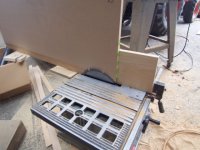
It took about 10 minutes to cut all the deep angles for both speakers. To do similar was a skill saw, build a right angle platform and clamp the vertical panel to it. Use a straightedge across the top to set the blade location and saw away. It will work perfectly.
Dennis
I gather Ron had some health problems, as well as a stressful, free-time forbidding dayjob. I have not seen him post for a long time. I hope he's OK.
Me too... i'd sure like to "see" him again.
dave
Hi Dave,
My plan is to run the black baseboard strips up the wall and to follow the outline of the speaker. I think that it will give it a nice art deco look.
I read the Dec Ware instructions and once had foam insulation in the gap. I couldn't tell the difference. Then I moved the speakers 6 inch out from the wall to measure for the black strips. I still couldn't tell the difference.
And thus the difference between theory and practice.
I just went out and set up the tone generator. Tight against the wall with no gasket, the most pronounced resonance is at 64 Hz. At 1.5 volts it is 96 dbC.
With a gasket, it is 96dbC. 6 inches away from the walls, it is 96dbC.
6 inches away from the walls, the most pronounced resonance drops to 63 HZ. I suspect this reflects the horn's larger mouth.
I repeated this test at 50 Hz and 110 Hz. No difference.
At 12 inches out, the bass drops big time.
If you think about it, at 110 Hz, the wave is about 10 feet long. I doubt that much of the wave can fit in a 1/2 inch crack.
I am calling this gasket myth Busted.
Steve also says that an alcove or opening "MUST" be between the speakers. Last month, I started testing out at the movie screen wall. Then I moved the speakers to another wall location in the same room that has an opening. No difference.
As mentioned before, the corner location and deep base makes for some really noticeable standing waves and voids. I believe that Steve has a rather small listening room and the standing wave problem there may be intense. An opening reduces this problem. I have a 16 foot garage door opposite the movie screen. When it's open, the standing waves are gone, along with some of the bass.
Steve also mentioned the second speaker acting as a bass trap. Mine didn't.
However, my speakers are 20 feet apart.
At this distance, its hard to tell if the speakers are even correctly phased.
Judging from the DecWare forums, there may only be 6 sets of these horns in existence. Until there are a lot more to compare, any observations should be taken with a big pinch of salt.
Including mine.
Dennis
My plan is to run the black baseboard strips up the wall and to follow the outline of the speaker. I think that it will give it a nice art deco look.
I read the Dec Ware instructions and once had foam insulation in the gap. I couldn't tell the difference. Then I moved the speakers 6 inch out from the wall to measure for the black strips. I still couldn't tell the difference.
And thus the difference between theory and practice.
I just went out and set up the tone generator. Tight against the wall with no gasket, the most pronounced resonance is at 64 Hz. At 1.5 volts it is 96 dbC.
With a gasket, it is 96dbC. 6 inches away from the walls, it is 96dbC.
6 inches away from the walls, the most pronounced resonance drops to 63 HZ. I suspect this reflects the horn's larger mouth.
I repeated this test at 50 Hz and 110 Hz. No difference.
At 12 inches out, the bass drops big time.
If you think about it, at 110 Hz, the wave is about 10 feet long. I doubt that much of the wave can fit in a 1/2 inch crack.
I am calling this gasket myth Busted.
Steve also says that an alcove or opening "MUST" be between the speakers. Last month, I started testing out at the movie screen wall. Then I moved the speakers to another wall location in the same room that has an opening. No difference.
As mentioned before, the corner location and deep base makes for some really noticeable standing waves and voids. I believe that Steve has a rather small listening room and the standing wave problem there may be intense. An opening reduces this problem. I have a 16 foot garage door opposite the movie screen. When it's open, the standing waves are gone, along with some of the bass.
Steve also mentioned the second speaker acting as a bass trap. Mine didn't.
However, my speakers are 20 feet apart.
At this distance, its hard to tell if the speakers are even correctly phased.
Judging from the DecWare forums, there may only be 6 sets of these horns in existence. Until there are a lot more to compare, any observations should be taken with a big pinch of salt.
Including mine.
Dennis
Nice work Dennis.
I bought the plans 2 years ago but keep getting put off by the angled cuts needed to put these together.
Cheers,
Alex
I did as well, but not so much put off by the complexity of build, as the fact that I don't really have an optimal room for them. Rear mouthed horns/BVRs that benefit from proximity to a corner are one thing, but having a room the right dimensions and actually being able to dedicate the corners and adjoining wall/floor space is what worried me. The only room over which I'm permitted full dominion is a narrow/long basement boy*cave - just over 8ft wide and 23ft long L-shaped
* clearly a "real" man would accept no such limitations, but I long ago dispensed with that self-delusion
Last edited:
The only room over which I'm permitted full dominion is a narrow/long basement boy*cave - just over 8ft wide and 23ft long L-shaped
* clearly a "real" man would accept no such limitations, but I long ago dispensed with that self-delusion
Man, that is a tough space to work with...
Real men understand the value of communication, consideration and compromise (I am told, consider resisting and settle for what I can get
Cheers,
Alex
I have wanted a pair of these for years but never had the right combination of time, tools money. Currently I don't have the time or tools. I have always hopped that I would find someone within my state or a neighboring state who was building a pair who I could pay to build me a pair or to work together with. I found someone selling a finished pair but they want quite a bit more then I could afford. Maybe one day it will happen. I would love to hear those speakers in a room with proper acoustical treatment and my Decware amp.
Member
Joined 2009
Paid Member
That's a nice build, makes it look easy - I'm tempted. If any of you guys who have a pair of these corner horns are still using them I'd be interested to know how you feel about them after the test of time, and I may have a couple of questions...
I have now had mine for close to two years and they still fascinate me and others that have heard them. The middle and high end sounds like any other Fostex full range speaker. It is down in the lower end where so much of the body of the music lives that these speakers are different from others.
Having some time to analyze and compare with other high end speakers, I believe that the Dec Horns have much lower low end distortion than speakers of other configurations. From 50 to 200 HZ the music is incredibly clean. Everyone who listens comments on it.
A Dec Horn with a 6 inch Fostex provides equivalent base to a 12 inch woofer.
I suppose that it makes sense that very very light weight cones that only move maybe 1/16 inch at fairly high sound volumes will have less distortion than big massive cones slamming the air into submission.
I also think that the design of the Dec Horns provides less distortion than other horns. They have only one change of direction from throat to mouth instead of the labyrinth of changes found in other horns.
They definitely need to be placed in corners. My previous comments about the corner placement leading to all sorts of standing wave issues are now pretty much moot. Mine are out in a 500 square foot shop, but having added some more machinery and a couple of material racks, the standing waves have disappeared.
Build them and you will have a unique looking and wonderful sounding set of speakers.
My previous offer still stands. Buy a set of plans from Steve and e-mail me that you actually have bought the plans and I will send you a set of plywood templates that will really help in aligning all the little vertical panels that make up the cabinets.
Dennis
I have two Fostek FE167E's and the plans for this forthcoming from a member here that decided not to proceed on this project. I plan on cutting as many pieces as possible on my CNC router.
I wonder how much "simplification" of this design I can get away with? For example, how necessary is the front curvature of the horn on either side of the driver? Since the horn only goes to 110 Hz I cannot imagine it making a difference. If it were straight it would save alot of sanding and filling.
A couple of things cutting via CNC come to mind, first the top and bottom will be rabbeted to fit all the panels to facilitate alignment. Second, I can program the cutting bit to cut the weird miters on the pieces as well.
Here is a thread I did of another horn speaker, a University Dean (prior to knowing how to cut miters on the machine).
University Speaker "Dean" similar to "Classic" 3D Model and Build - AudioKarma.org Home Audio Stereo Discussion Forums
I wonder how much "simplification" of this design I can get away with? For example, how necessary is the front curvature of the horn on either side of the driver? Since the horn only goes to 110 Hz I cannot imagine it making a difference. If it were straight it would save alot of sanding and filling.
A couple of things cutting via CNC come to mind, first the top and bottom will be rabbeted to fit all the panels to facilitate alignment. Second, I can program the cutting bit to cut the weird miters on the pieces as well.
Here is a thread I did of another horn speaker, a University Dean (prior to knowing how to cut miters on the machine).
University Speaker "Dean" similar to "Classic" 3D Model and Build - AudioKarma.org Home Audio Stereo Discussion Forums
I have two Fostek FE167E's and the plans for this forthcoming from a member here that decided not to proceed on this project. I plan on cutting as many pieces as possible on my CNC router.
I wonder how much "simplification" of this design I can get away with? For example, how necessary is the front curvature of the horn on either side of the driver? Since the horn only goes to 110 Hz I cannot imagine it making a difference. If it were straight it would save alot of sanding and filling.
A couple of things cutting via CNC come to mind, first the top and bottom will be rabbeted to fit all the panels to facilitate alignment. Second, I can program the cutting bit to cut the weird miters on the pieces as well.
Here is a thread I did of another horn speaker, a University Dean (prior to knowing how to cut miters on the machine).
University Speaker "Dean" similar to "Classic" 3D Model and Build - AudioKarma.org Home Audio Stereo Discussion Forums
I would guess that you can simplify the curved front a lot and it will still work as long as the volume in the rear chamber is similar. I plan on making a second set this summer and using 8 inch Fostek EN drivers. That will entail widening the fronts a bit.
If you cut the bevels per plan, the fronts are almost curved.When I built mine, I curved the front of one speaker with bondo. The other I left raw. From five feet back, you cannot see the difference.
I read that you have a ShopBot. I cut the fronts and internal small pieces on my ShopBot. Most important, I engraved the template on the top and bottom panels. This made it easy to align the vertical panels. Use a t-square on everything. If any of the vertical panels are tilted, it all goes wonky fast.
Last week I was visited by a guy building a set of these horns. I loaned him my engraved templates and he called and said that they really made a difference.
If I was doing it again, I would cut everything out with the ShopBot, not to save time, but to use the sawdust collector. There is a ton on MDF dust to be gathered on each cut and there are a lot of cuts.
I bevel 45 degree cuts on the SB by using a 45 degree v-bit. If the panels are small, I just tip the piece up with shims and plane the bevel angle on it with a face cutter. Everything else, I use a 1/4 inch bit with a 40% stepover and stair step my way up to the correct bevel. If you have a better method of making CNC bevels, I would love to hear about it.
Do you have Partworks with your Shopbot? If so, use the Create Fluting Toolpath and in my case, the same 1/4" flat endmill bit as I cut the parts out with. What you do is start the flutes (I made mine .15" apart) at the top of the material and have the tool go down the "incline" ---which of course is specified by the user -- till it reaches the bottom. You have to be careful with your layout to make sure you start and stop the bit at the correct place. At .15 spacing the "cut" has noticeable teeth but if you shift the adjacent part's fluting vectors by half that distance it fits together really nice. If you want virtually no teeth, go with .075 but of course that takes twice as long to machine. These teeth are not stair steps but lengthwise from the top of the material to the bottom. For example, one of these vectors cutting a 45 degree angle on 1 inch thick material would be 1.414 inches long.
I can't find a photo or scrap piece right now of the results but would be happy to send you a Partworks file of how I do this...
I can't find a photo or scrap piece right now of the results but would be happy to send you a Partworks file of how I do this...
Last edited:
Member
Joined 2009
Paid Member
I have now had mine for close to two years and they still fascinate me and others that have heard them. The middle and high end sounds like any other Fostex full range speaker. It is down in the lower end where so much of the body of the music lives that these speakers are different from others.
Having some time to analyze and compare with other high end speakers, I believe that the Dec Horns have much lower low end distortion than speakers of other configurations. From 50 to 200 HZ the music is incredibly clean. Everyone who listens comments on it.
A Dec Horn with a 6 inch Fostex provides equivalent base to a 12 inch woofer.
I suppose that it makes sense that very very light weight cones that only move maybe 1/16 inch at fairly high sound volumes will have less distortion than big massive cones slamming the air into submission.
I also think that the design of the Dec Horns provides less distortion than other horns. They have only one change of direction from throat to mouth instead of the labyrinth of changes found in other horns.
They definitely need to be placed in corners. My previous comments about the corner placement leading to all sorts of standing wave issues are now pretty much moot. Mine are out in a 500 square foot shop, but having added some more machinery and a couple of material racks, the standing waves have disappeared.
Build them and you will have a unique looking and wonderful sounding set of speakers.
My previous offer still stands. Buy a set of plans from Steve and e-mail me that you actually have bought the plans and I will send you a set of plywood templates that will really help in aligning all the little vertical panels that make up the cabinets.
Dennis
sorry, I didn't see your response to my post - I guess there was a bit of a time gap between them. Anyhow, very interesting to read about your experience with the corner horn. I haven't made a decision about building them yet - the issue is making sure I have a corner to use one in before committing to it.
That's a really nice offer on the templates - will bear it in mind.
The corner I have available isn't huge, there's a window near the corner, I probably have 18 inches of space.
- Status
- This old topic is closed. If you want to reopen this topic, contact a moderator using the "Report Post" button.
- Home
- Loudspeakers
- Full Range
- DecWare Corner Horns
